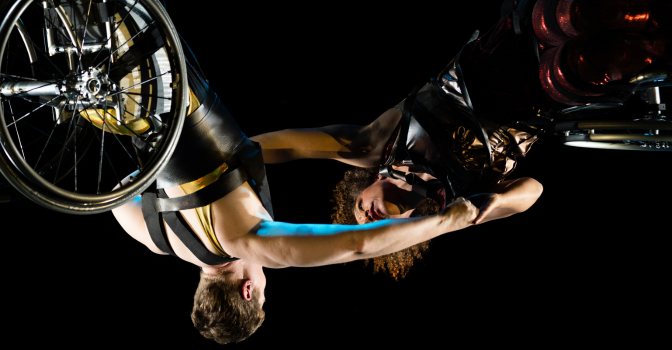Key points:
- In dance performance, people assume that sight is the only way to experience it – it’s not.
- Audimance is the first app that allows audiences to create their own experience of a dance.
- Disability is not a deficit; it’s a powerful intersectional creative force.
Kinetic Light is an internationally recognised disability arts ensemble. They work in the disciplines of art, technology, design and dance. Kinetic Light creates, performs and teaches at the intersection of access, queerness, disability, dance and race.
Everything they do centres around access, equitable artistic access and the conversations, politics and values of the disability community. Since its inception, technology has been a key tool for both the performers and audience.
Founder Alice Sheppard comments: “The means of experiencing a work of art should not prioritise sight. It doesn’t have to. There are dedicated auditory and sonic arts, but mostly, if you go to a dance performance, people assume that sight is the only way to experience it, and it’s not. Once you’ve taken that wall away, you open up a massive creative pathway to think about multiplicity and access in conversation with each other.”
The journey from glitch to innovation.
Back in 2016, after the first showing of Kinetic Light’s performance ‘Descent’, the team noticed a glitch in the audio description. Audio description allows audiences to experience the performance primarily through sound. Typically, someone in the back of the theatre, often in a booth, watches the performance and narrates it through a microphone to the audience via special short-range headsets.
Despite having a fabulous audio describer, things were missing. Feedback from friends and colleagues in the audience told them, “We could hear people leaning forward in their seats. We could hear them gasp, we felt them holding their breath, and there wasn’t anything like that in the audio description. What did we miss?”
This set off the product design journey for co-founder Laurel Lawson, Kinetic Light’s choreographic collaborator, dancer, designer and engineer. After some iteration and a lot of testing, Audimance is the result.
Laurel explains: “Audimance permits us to deliver audio description in multiple tracks, multiple forms. Sound as rich, complex and varied tracks that allow the listener to choose between poetry, soundscape, movement, lighting, the environment, the narrative or all of them at once.”
Audimance is the first app that allows audiences to create their own experience of a dance. Using an innovative interface, audience members can access specially developed sound content and choose what to listen to and when. Kinetic Light’s ongoing practice of multitrack description and spatialised aural experience often uses seven to twelve tracks in newer works.
Integrating accessibility into the creative process.
The company sees accessibility as a key part of their work and creative process. If you visit one of their rehearsals, you’ll likely find them discussing how to make their choreography accessible for audiences who are blind, have low sensory input, or are deaf. Accessibility isn’t an afterthought for them. They want you, the audience, to fully experience the art, not just hear a description of it.
Led by artists with disability who create, design and perform, their work speaks to and emerges from disability aesthetics and disability culture and is connected to the rich traditions and exciting contemporary conversations of disabled artists in all artistic fields.
Laurel also designs the costumes and makeup, contributes technical and production design, and designs the wheelchairs she and Alice Sheppard use in performance. This combination of artistic creativity and tech engineering has made her a noted public speaker on how to cultivate creativity and drive innovation.
She comments: “The critical thing when you’re designing for other people is to remember that you need to centre the people you’re designing for. That means de-centring yourself, which is really hard. We’re all the centres of our own universe, right? I know I am. But that leads to designing products that work for me. So, at its core, I often say design is the discipline of getting out of the way, letting your users lead.”
In their work, disability is not a deficit; it’s a powerful intersectional creative force that is essential to their artistry and access is integral to their art and creative process.
Expanding access with Audimance.
The Audimance app is designed to be compatible with most people’s phones or tablets. By focusing on consumer technology, it makes it possible for attendees to access descriptions at venues of all sizes. Once ready for wider release, Audimance will be available to artists, companies and venues to develop content, create access and provide this kind of experience to their audiences.

